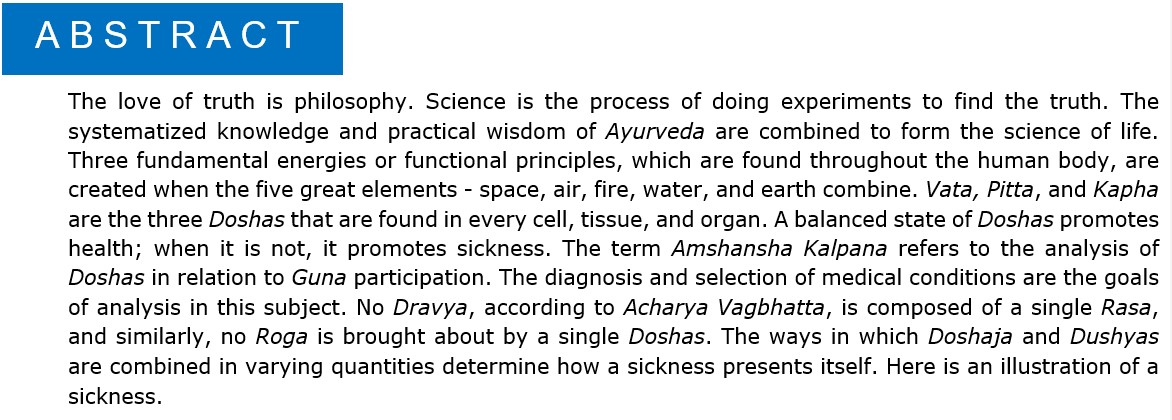Amshansha Kalpana : A Quantitative Interpretation of the properties of Doshas in sickness
DOI:
https://doi.org/10.21760/jaims.8.11.24Keywords:
Amshansha Kalpana, Doshas, DravyaAbstract
The love of truth is philosophy. Science is the process of doing experiments to find the truth. The systematized knowledge and practical wisdom of Ayurveda are combined to form the science of life. Three fundamental energies or functional principles, which are found throughout the human body, are created when the five great elements - space, air, fire, water, and earth combine. Vata, Pitta, and Kapha are the three Doshas that are found in every cell, tissue, and organ. A balanced state of Doshas promotes health; when it is not, it promotes sickness. The term Amshansha Kalpana refers to the analysis of Doshas in relation to Guna participation. The diagnosis and selection of medical conditions are the goals of analysis in this subject. No Dravya, according to Acharya Vagbhatta, is composed of a single Rasa, and similarly, no Roga is brought about by a single Doshas. The ways in which Doshaja and Dushyas are combined in varying quantities determine how a sickness presents itself. Here is an illustration of a sickness.
Downloads
References
Shastri Hari Sadashiva (Editor) of Ashtanga Hridaya Hemadri Commentary by Arunadatta Chikitsa Sthana, Chapter 7 Verse 34-36, 10th Ed. By, Chaukhambha Orientalia, Varanasi. (India); 2011.P.452
Das JR, Das HB, Mandal SK, Sharma SK. Role of Vikalpa Samprapti in disease in context to Prameha: A Review. IAMJ. 2015; 3:1. Accessed on 2nd December 2019
Shastri Hari Sadashiva (Editor) of Ashtanga Hridaya Hemadri Commentary by Arunadatta Sutra Sthana, Chapter 20, Verse 12, 10th Ed. By, Chaukhambha Orientalia, Varanasi. (India); 2011.P.114
Shastri Hari Sadashiva (Editor) of Ashtanga Hridaya Hemadri Commentary by Arunadatta Sutra Sthana, Chapter 20, Verse 12, 10th Ed. By, Chaukhambha Orientalia, Varanasi. (India); 2011.P.114
Kuntal Ghosh, M.S. Baghel. A clinical Study to Evaluate the Role of Doshik Predominance in the Management of Amlapitta: Ayu.2018; 38; 1-2 June 2017 Accessed On July 2019 http://www.ayujournal.org















